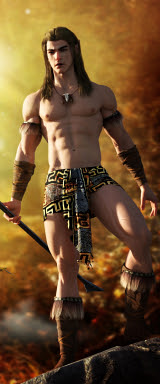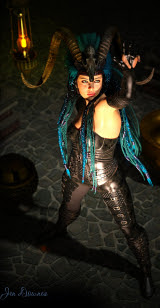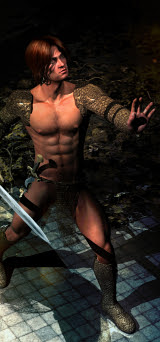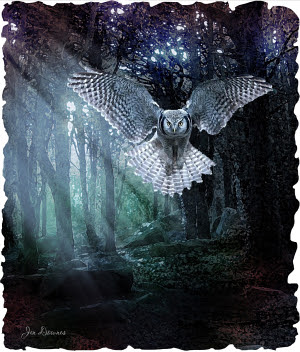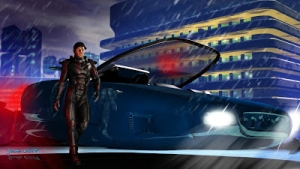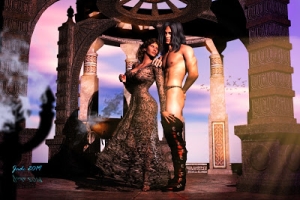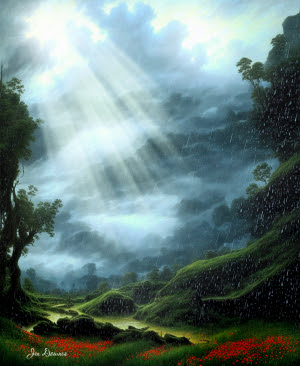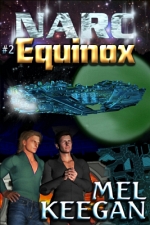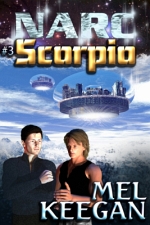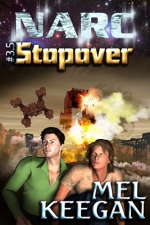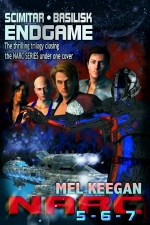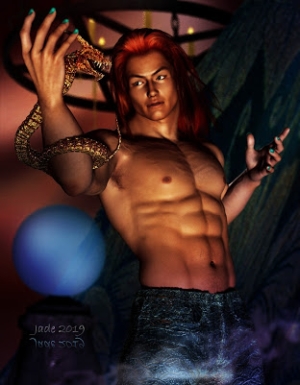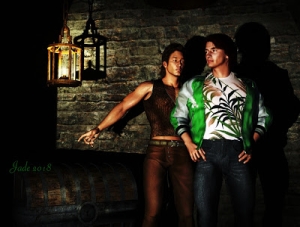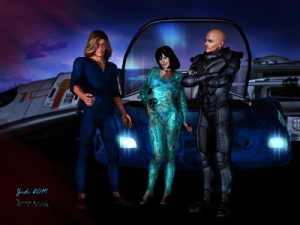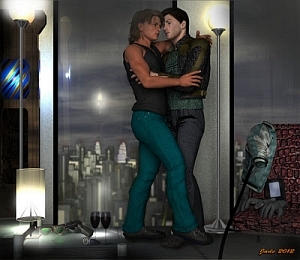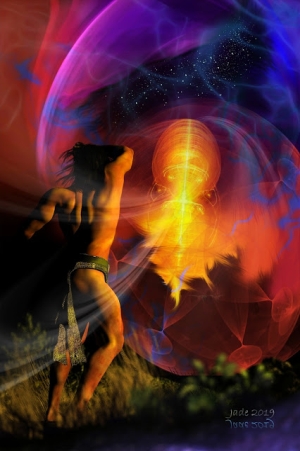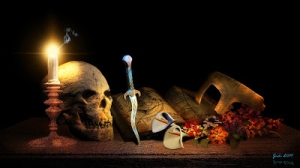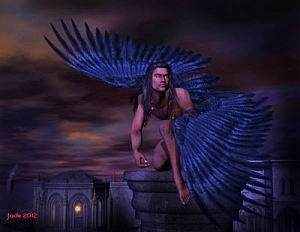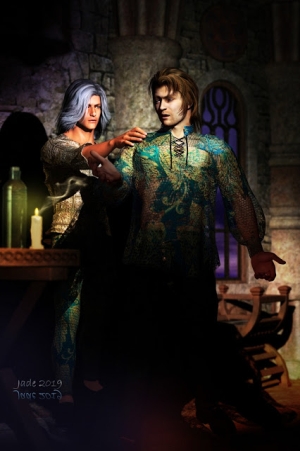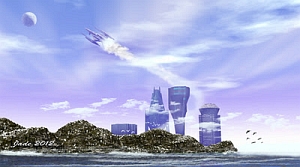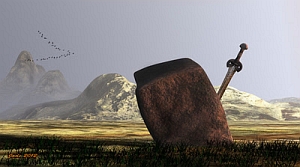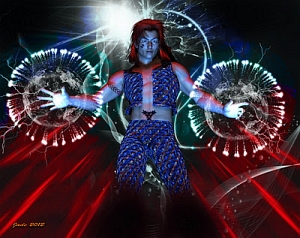I haven't actually died and/or been abducted by aliens, but I have to confess, there were times when it seemed like it was happening ... and times when it could have been preferable to what was actually going on! If you've been following this blog at all, you'll might recall how Dave and I started to move house in November. We managed the move, with the final date when every last matchstick and bottle cap had to be out of the old house as of January 10, and in the last two weeks we've 1) recovered, 2) healed up of most of the myriads of physical injuries you always do yourself during this kind of work (it's an unwritten law), and 3) unpacked.
A promise I made to myself: I will not indulge myself in artwork till the last box is unpacked!
Wellll ... there's about two left. Near enough's good enough.
[Edit: links have been deleted here, because The Bookshelf has been gone for years and years now]
And along came a challenge I couldn't resist. Kit Moss, of the Our Story Historical Fiction pages at the GLBT Bookshelf wiki, asked me if I could do something as rich and evocative as the pieces I did previously to head off the Fireside with Lichen Craig section of the same site. The Fireside art featured a, well, a fireside with chairs, candles, clock, decanter and books galore (see the art here), and it was probably somewhat easier than you might have imagined, because it didn't involve figures. Figure work almost always entails either costuming or props or both, to set said figures into a context -- historical, fantasy, SF, what have you. Kit Moss asked me for a historical setting, preferably the Crusades era, the Roaring Twenties, Ancient Rome, that kind of thing --
And I blush to confess, I don't actually own the costumes or props to wrangle those. 3D models aren't all that expensive, but when you're fleshing out a whole 3D universe inside your computer, and you have to purchase everything from a coffee mug to a space-going aircraft carrier ... it gets expensive due to the sheer volume of stuff you're buying. Somewhere, you gotta draw a line or you'll lay down enough money to buy a new car! So I wound up with a lot of SF and fantasy props and costumes, because they lend themselves so well to the kind of art I like to do for my own amusement (and also for the NARC and Hellgate art, which I love doing -- the SF worlds of Mel Keegan. You know. Of course you do.). But I never did get around to buying much in a historical vein, because I don't do very much work in that context...
Sooo, how was I going to wrangle a historical setting, with figures?
Aha! Inspiration struck. Unclad figures against a backdrop. I started looking at landscapes and images from Rome and Greece, but the problem is, those buildings are all in ruins today. Using a modern day image of a Roman or Greek site would give us an image of a couple of gorgeous, nekkid lads canoodling while on vacation, somewhere in Europe in the summer of 2012! Then I thought, how about using something like a Roman classical mosaic, and Photoshop it into ninth dimension for effect?
It was a good idea, and would have worked; but not nearly as well as starting with a classical painting and zapping it into the ninth dimension, though Photoshop!
The sound you can hear is probably an artist by the name of Thomas Couture spinning in his grave, because the work I've just done is highly derivative, and without Thomas Couture's background, it would just be a couple of gorgeous young dudes standing in front of a big green screen.
So, who's this Couture guy? Over to Wikipedia for this:
Thomas Couture (21 December 1815 – 30 March 1879) was an influential French history painter and teacher. Couture taught such later luminaries of the art world as Édouard Manet, Henri Fantin-Latour, John La Farge,[1] Pierre Puvis de Chavannes, Karel Javůrek, and J-N Sylvestre.
He was born at Senlis, Oise, France. At age 11, Thomas Couture's family moved to Paris where he would study at the industrial arts school (École des Arts et Métiers) and later at the École des Beaux-Arts. He failed the prestigious Prix de Rome competition at the École six times, but he felt the problem was with the École, not himself. Couture finally did win the prize in 1837.
In 1840, he began exhibiting historical and genre pictures at the Paris Salon, earning several medals for his works, in particular for his 1847 masterpiece, Romans in the Decadence of the Empire. Shortly after this success, Couture opened an independent atelier meant to challenge the École des Beaux-Arts by turning out the best new history painters.
Couture's innovative technique gained much attention, and he received Government and Church commissions for murals during the late 1840s through the 1850s. However, he never completed the first two commissions, while the third met with mixed criticism. Upset by the unfavorable reception of his murals, in 1860 he left Paris, for a time returning to his hometown of Senlis, where he continued to teach young artists who came to him. In 1867 he thumbed his nose at the academic establishment by publishing a book on his own ideas and working methods called "Méthode et entretiens d'atelier" (Method and workshop interviews). It was also translated to "Conversations on Art Methods" in 1879, the year he died.
Asked by a publisher to write an autobiography, Couture responded "Biography is the exaltation of personality—and personality is the scourge of our time." He died at Villiers-le-Bel, Val-d'Oise, and was interred in Père Lachaise Cemetery, Paris.
The "Romans of the Decadence" painting is the one he's famous for, and rightly so. It's amazing. It's so amazing, one almost hesitated to mess with it. Almost. Well, it was painted over 160 years ago, and Thomas died over 130 years ago, so it's well and truly "out of copyright," and the only sin I could commit (and y'all know me far better than that!) would be failing to give due credit for the base work on which the derivative art was built.
So here you go:
Then, with this achieved, I could repaint great swathes of it with "false color," reds, golds, purples, which lead the eye to and fro, and generate an emotional reaction --
And along came a challenge I couldn't resist. Kit Moss, of the Our Story Historical Fiction pages at the GLBT Bookshelf wiki, asked me if I could do something as rich and evocative as the pieces I did previously to head off the Fireside with Lichen Craig section of the same site. The Fireside art featured a, well, a fireside with chairs, candles, clock, decanter and books galore (see the art here), and it was probably somewhat easier than you might have imagined, because it didn't involve figures. Figure work almost always entails either costuming or props or both, to set said figures into a context -- historical, fantasy, SF, what have you. Kit Moss asked me for a historical setting, preferably the Crusades era, the Roaring Twenties, Ancient Rome, that kind of thing --
And I blush to confess, I don't actually own the costumes or props to wrangle those. 3D models aren't all that expensive, but when you're fleshing out a whole 3D universe inside your computer, and you have to purchase everything from a coffee mug to a space-going aircraft carrier ... it gets expensive due to the sheer volume of stuff you're buying. Somewhere, you gotta draw a line or you'll lay down enough money to buy a new car! So I wound up with a lot of SF and fantasy props and costumes, because they lend themselves so well to the kind of art I like to do for my own amusement (and also for the NARC and Hellgate art, which I love doing -- the SF worlds of Mel Keegan. You know. Of course you do.). But I never did get around to buying much in a historical vein, because I don't do very much work in that context...
Sooo, how was I going to wrangle a historical setting, with figures?
Aha! Inspiration struck. Unclad figures against a backdrop. I started looking at landscapes and images from Rome and Greece, but the problem is, those buildings are all in ruins today. Using a modern day image of a Roman or Greek site would give us an image of a couple of gorgeous, nekkid lads canoodling while on vacation, somewhere in Europe in the summer of 2012! Then I thought, how about using something like a Roman classical mosaic, and Photoshop it into ninth dimension for effect?
It was a good idea, and would have worked; but not nearly as well as starting with a classical painting and zapping it into the ninth dimension, though Photoshop!
The sound you can hear is probably an artist by the name of Thomas Couture spinning in his grave, because the work I've just done is highly derivative, and without Thomas Couture's background, it would just be a couple of gorgeous young dudes standing in front of a big green screen.
So, who's this Couture guy? Over to Wikipedia for this:
Thomas Couture (21 December 1815 – 30 March 1879) was an influential French history painter and teacher. Couture taught such later luminaries of the art world as Édouard Manet, Henri Fantin-Latour, John La Farge,[1] Pierre Puvis de Chavannes, Karel Javůrek, and J-N Sylvestre.
He was born at Senlis, Oise, France. At age 11, Thomas Couture's family moved to Paris where he would study at the industrial arts school (École des Arts et Métiers) and later at the École des Beaux-Arts. He failed the prestigious Prix de Rome competition at the École six times, but he felt the problem was with the École, not himself. Couture finally did win the prize in 1837.
In 1840, he began exhibiting historical and genre pictures at the Paris Salon, earning several medals for his works, in particular for his 1847 masterpiece, Romans in the Decadence of the Empire. Shortly after this success, Couture opened an independent atelier meant to challenge the École des Beaux-Arts by turning out the best new history painters.
Couture's innovative technique gained much attention, and he received Government and Church commissions for murals during the late 1840s through the 1850s. However, he never completed the first two commissions, while the third met with mixed criticism. Upset by the unfavorable reception of his murals, in 1860 he left Paris, for a time returning to his hometown of Senlis, where he continued to teach young artists who came to him. In 1867 he thumbed his nose at the academic establishment by publishing a book on his own ideas and working methods called "Méthode et entretiens d'atelier" (Method and workshop interviews). It was also translated to "Conversations on Art Methods" in 1879, the year he died.
Asked by a publisher to write an autobiography, Couture responded "Biography is the exaltation of personality—and personality is the scourge of our time." He died at Villiers-le-Bel, Val-d'Oise, and was interred in Père Lachaise Cemetery, Paris.
The "Romans of the Decadence" painting is the one he's famous for, and rightly so. It's amazing. It's so amazing, one almost hesitated to mess with it. Almost. Well, it was painted over 160 years ago, and Thomas died over 130 years ago, so it's well and truly "out of copyright," and the only sin I could commit (and y'all know me far better than that!) would be failing to give due credit for the base work on which the derivative art was built.
So here you go:
There it is, in entirety, and in its original colors, before I took it into Photoshop and began to do heinous things to it. The background I wanted for the new iconic render was dark, mysterious, perhaps a little ominous, rather "pregnant with every potential," including terrible danger. It had to say all of this through the means of color, shadow, contrast, and the way those three qualities can bias the eye to seeing things, and inspiring emotions.
So, step one was to get rid of almost all the native color of the piece, and at the same time render it down to something much more like a drawing than an oil painting:
-- especially when the background was shipped into DAZ Studio and used as the backdrop for the figures:
The figures are color toned to look like they're part of the scene, and many of the shadows on both them and the background were hand painted after the render, to agree. I also hand painted the hair on the blond guy; and those face and body morphs were crafted specifically for this piece. I stood a column right behind them, so there's one piece of architecture in the foreground, with right-falling shadows, which helps to male background and foreground "merge" convincingly.
The last thing to do was the text object overlays. The sharp-eyed will notice that I painted down a swathe of the background with a matte, something like a drop shadow, to make the title stand out. The font, incidentally, is Vivaldi, around 40 point ( I love the capitals:); and the composition work involving text was not done in Photoshop, but in Serif. I'm still using Page Plus X3, because it does everything I need to do; they tell me Serif X6 is out now, but I feel no compulsion to rush away and get it. So here's the final composition:
Then, resize it to the 700-wide format that's most useful on the website where it'll be appearing, and it was done. The result is so attractive -- it has a depth that I find irresistible -- and the assignment was a lot of fun. Thanks to Kit Moss for giving me the chance to do this!
What's next for me? For a start, get those last few boxes unpacked! Write the next segment of Abraxas, which has been haunting me since November --
I was asked, did I retitle Abraxas? It changed from The Forgotten Songs to The Lost Songs -- and I've just changed it back. Yes, I did retitle it, but frankly, I've come right back around to thinking that "Forgotten" works better than "Lost." So, yes, it was retitled; then switched right back again. Sorry about that. It seemed like a good idea at the time.
Also, I need to get back to Manga Studio, which I'd only just opened up when the necessity to shove my whole life into boxes arose. And during the "dead zone" of December, I began thinking about art and stories, and I'm dying to look at art that's developed in layers -- each layer rendered in DAZ-Reality-Lux, and then everything assembled in Photoshop. I can "see" some astonishing images in my mind's eye. Now, let's see if I can figure out how to winkle them out of there!
More soon. Soon.
Jade, January 24, 2013


















